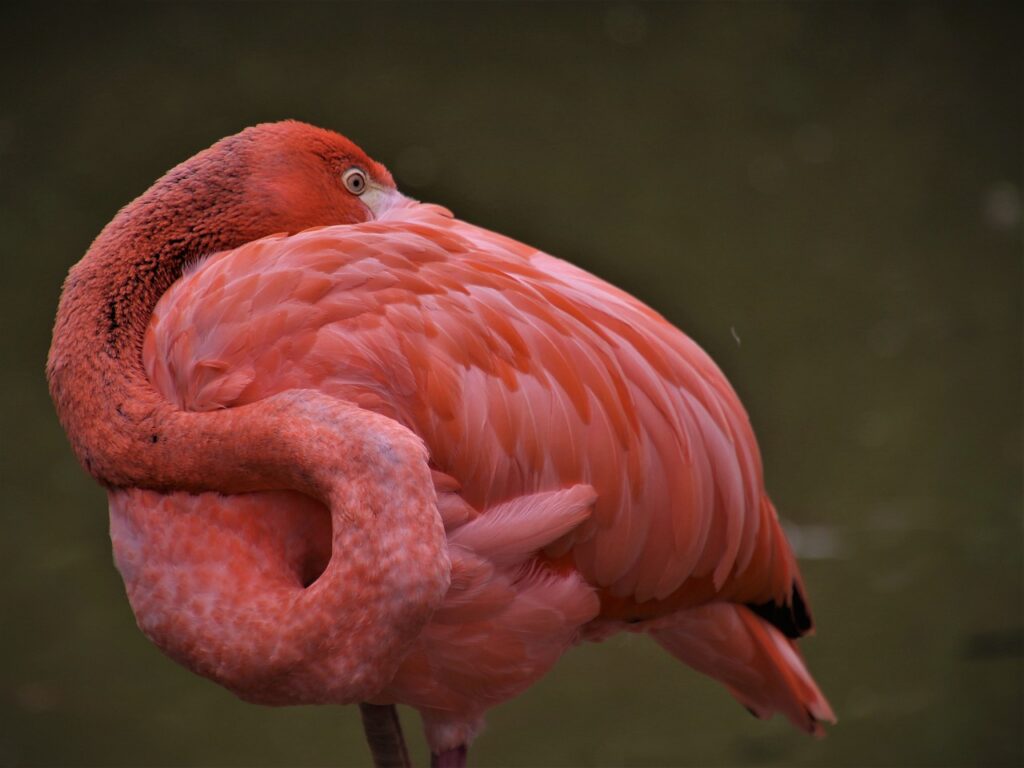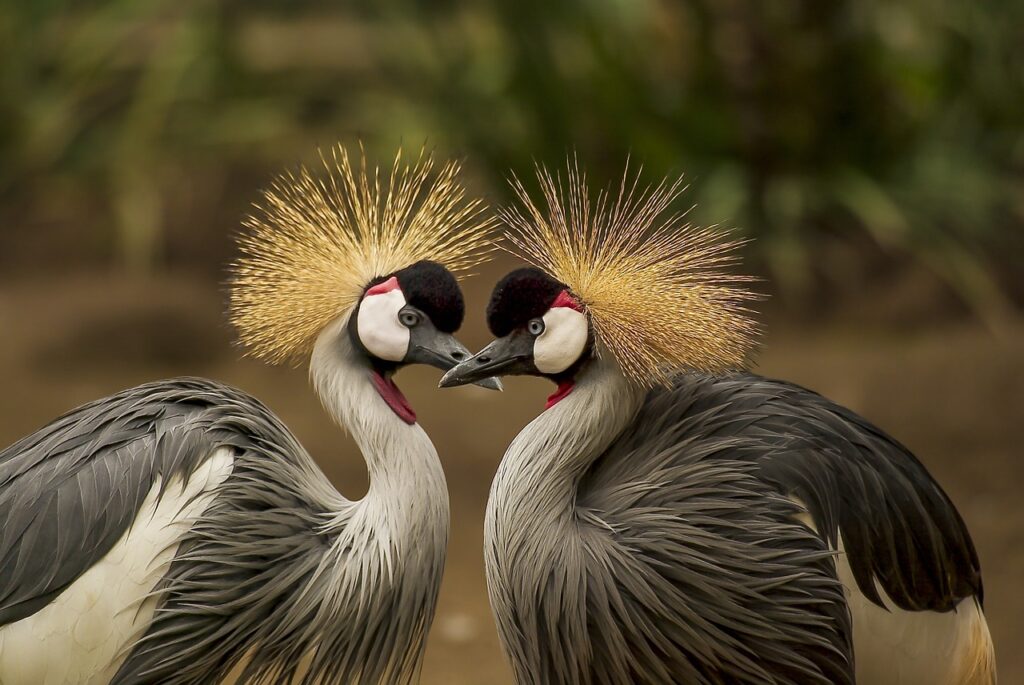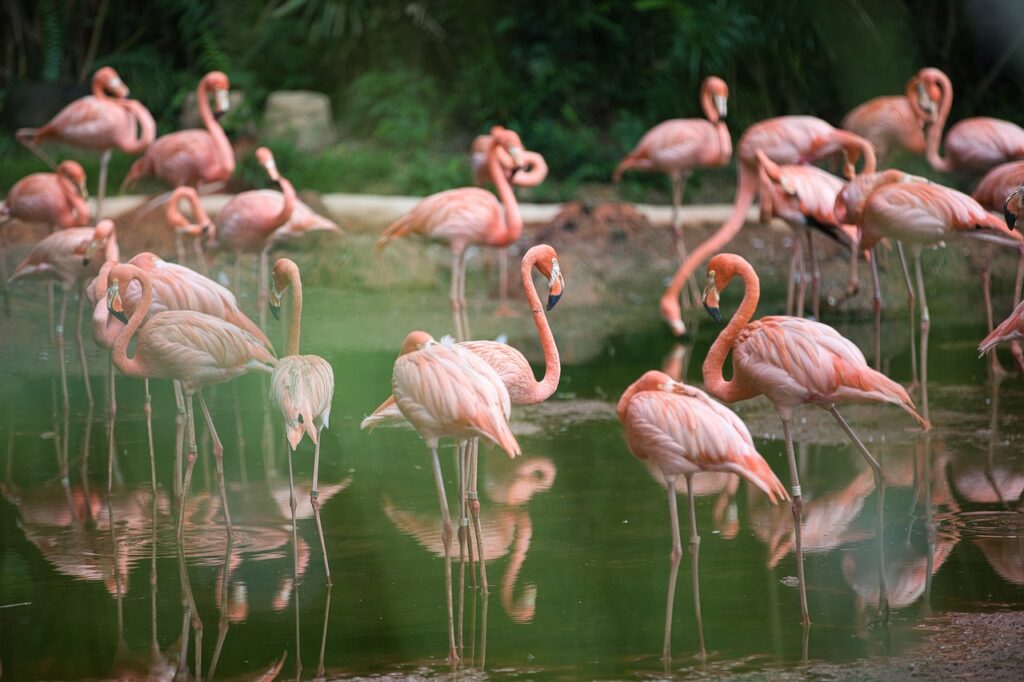FLAMINGOS AND CRANES: WHAT MAKES THEM DIFFERENT?
Standing on their long and stilt-like feet, flamingos and cranes are two birds associated with imageries of grace and poise. Both of them tend to frequent areas near the water to subsist on fish and another aquatic fare. Often, flamingos are mistaken for red-crowned cranes. But flamingos and cranes are vastly different, from their genetic profile to their behavior.
Listed below are some of the main differences between these two birds.
WHAT SEPARATES A FLAMINGO FROM A CRANE?
1. GENETICS
Flamingos ( Phoenicopterus ) are the only existing members of the order Phoenicopteriformes. Today, there are six existing species:
- The American flamingo ( Phoenicopterus ruber )
- The Chilean flamingo ( Phoenicopterus chilensis )
- The greater flamingo (Phoenicopterus roseus )
- The lesser flamingo ( Phoeniconaias minor )
- The Andean flamingo ( Phoenicoparrus andinus )
- James’ flamingo ( Phoenicoparrus jamesi )
From an evolutionary standpoint, flamingos are related to both storks and grebes.
Cranes are a diverse group of birds of the order Gruiformes. 15 species of cranes are still extant. Among its popular varieties are:
- The standard crane ( Grus grus ).
- The whooping crane ( Grus americana ).
- The red-crowned crane ( Grus japonensis ).
- The sandhill crane ( Antigone Canadensis ).
In terms of evolution, the cranes have emerged during the later part of the Eocene epoch, which was around 35 million years ago.
2. SIZE
Flamingos are of modest size. The greater flamingo is the most significant and averages 60 inches in height and 8 pounds in weight. It has a wingspan of about 65 inches. The lesser flamingo is the most miniature variety. It is about 32 inches tall. It weighs about 6 pounds and has an average wingspan of 40 inches.
Cranes are the tallest flying birds in the world. They are classified as large birds. The red-crowned crane is the largest of the cranes. A mature red-crowned crane stands at an average height of 5 feet. It has a wingspan of approximately 8 feet and an average body weight of 25 pounds. The smallest is the demoiselle crane ( Grus Virgo ), an average height of 36 inches and an average weight of 6 pounds.
3. APPEARANCE
Flamingos are easily recognizable due to the color of their plumage, which ranges from light pink to deep crimson. The reddish color of their feathers is attributed to their habit of consuming algae which contains carotenoid. These algae are also consumed by shrimps which, in turn, are part of the flamingo’s staple diet. The carotenoid is responsible for producing orange-red pigments that account for the colors of carrots, shrimps, and flamingos. The feet of flamingos are longer than their bodies and are specialized to help them wade through relatively deep water. They have long and flexible necks, downward-pointing bills that are designed for filter-feeding. Flamingos are capable of swimming and flying at high altitudes.

The color of the crane’s plumage varies per species. In general, they share the same physical characteristics of having long legs and necks, sharp bills, and large and wide wings that allow them to fly at great altitudes.

4. BEHAVIOR
Flamingos live in large flocks that have an average of 70 members. These birds generally spend most of their time grooming their feathers and wading in water to scavenge for food. It is common for them to feed all day and all night when they are within their breeding periods. Flamingos typically do not migrate, but they are capable of flying at high altitudes. They tend to move over short distances when food becomes scarce or some changes in the water quality. In the few instances when they do migrate, flamingos prefer to fly on cloudless and windy nights. They can cover long distances.
Cranes are known for their monogamy. They live as breeding pairs for the duration of their lives. These pairs are known for maintaining wide territories, which they will aggressively protect. When they breed, cranes typically create a floating nest in shallow water. Chicks are protected by their parents but can be abandoned once the next breeding season comes. Cranes are migratory. Their large and powerful wings can carry them across great distances and high altitudes. Cranes have been sighted flying above and around the Himalayan peaks.
5. HABITAT
Flamingos live in tropical and subtropical regions. They live along big lakes and estuaries that have little vegetation. They usually prefer bodies of water that are saline. They can also be found in mangrove clusters, intertidal coasts, and tropical islands. Where there is a steady population of fish and other aquatic creatures, flamingos will thrive.
Cranes are found in all continents, except South America and Antarctica. Cranes generally live around bodies of water, although there may be some differences in terms of their particular habitats. Depending on the species and geography, cranes thrive in wetlands, swamps, desert borders, and open grasslands. With the gradual incursion of human civilization into their natural habitats, some cranes have learned to live in farmlands and city parks.
6. DIET
Flamingos hunt for food by standing on the shallow portions of the water. They sweep the water below the surface with their large bills, straining for fish, shrimps, and small creatures. When they raise their heads, they filter the water out and then use their tongues to manipulate their food down their throat. They would often disturb the bottom of the water to bring small fish and creatures closer to the surface. Shellfish, shrimps, small fish, algae, and small insects comprise the main diet for flamingos.
Cranes are opportunistic feeders. They will consume anything, depending on the season and scarcity. They eat animals and plants. They can forage for seeds, nuts, and rhizomes. But they will also prey on small mammals, insects, and small birds. In the water, they eat fish and amphibians. They rely on their long bills and flexible necks to probe for edibles.
QUESTIONS AND ANSWERS ABOUT FLAMINGOS AND CRANES
HOW DO FLAMINGOES AND CRANES REACT TO HUMAN PRESENCE?
Flamingos, particularly the Chilean flamingo, are very aggressive. They are prone to attack other animals and even humans who venture into their spaces. Flamingos gather in large flocks. When there is a perceived threat, these large flocks will band together and attack. Even in captivity, flamingos are largely left alone. Interacting with them intimately is usually not allowed.
Cranes do not usually attack unprovoked. But just like flamingos, they will become aggressive and can attack when you get too close to them.
WHY ARE CRANES POPULAR IN CHINESE MARTIAL ARTS?
Cranes are totemic animals that are an integral part of the folklore and practice of Chinese martial arts. According to legend, the Fujian White Crane school emerged after female martial artists observed the movement and behavior of the cranes in her region. The crane technique is characterized by the use of the arms and the fists to imitate the pecking action when it hunts for food or attacks threats. The most iconic representation of the crane in martial arts and popular culture is in the film, The Karate Kid.
Are CRANES AND FLAMINGOS SACRED IN SOME CULTURES?
In Asia, cranes are considered auspicious mythological animals, along with the dragon, the tortoise, the tiger, and the phoenix. They are symbols of youthful presence and energy. In Greek mythology, the cranes are associated with the creative energy of the deities Apollo and Hephaestus.
Flamingos are also associated with divine concepts. For the Egyptians, the flamingo was closely associated with the sun god Ra. The flame-like plumage of the flamingos symbolized the power and majesty of the sun. In some parts of South America, the flamingo is considered the divine guardian that watches over the borders that separate the earthly and spiritual realms. This belief is rooted in the fact that flamingos are comfortable in all environments. They live on land and in the water. They are also capable of flying at great heights and across great distances.
IS THE FLAMINGO THE INSPIRATION FOR THE FLAMENCO?
No, but both are named after the Spanish and Portuguese words that can be interpreted as “flame.” The flamenco dance is rooted in the intensity of gypsy culture, where it supposedly came from. Therefore, flamenco references both the flame-like movements of the dancer, as well as the passionate heritage of its proponents. The name of the flamingo bird also comes from the flame-like color of its feathers.
WHAT ARE PLASTIC FLAMINGOS?
Plastic flamingos are very popular decorations for the lawn, along with garden gnomes. The iconic pink lawn flamingo was first designed and produced by the artist Don Featherstone in 1957. It has become a ubiquitous symbol for kitsch and pop culture. Interestingly, the kitschy nature of the plastic flamingo is why there are banned in some exclusive neighborhoods and by some homeowners’ groups. There is a belief that real estate value is impacted negatively whenever it has flamingo lawn ornaments.
CAN CRANES INTERBREED?
Yes, it is possible. A well-documented case where a crane chick has been discovered to be possibly a hybrid between the whooping crane and the sandhill crane. This purported crane hybrid has been affectionately named “Whoopsie.”

